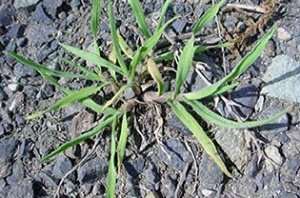Field Guide  Weed Management
Weed Management  Cheatgrass
Cheatgrass
Cheatgrass (Bromus tectorum)
Crop Impacts: Wheat and cattle fields (because of over grazing)

| |
About Cheatgrass:Cheatgrass is an invasive and aggressive weed native to Eurasia. Due to soil coming over via ships, this weed has now dominated the environment in western North America and along the eastern side of the Rocky Mountains. This grass can be found along roadsides and has started to merge into grasslands and areas with low elevation. It is known for appearing in areas that have been disrupted due to events such as fires and floods, along with undisturbed areas. Once this destructive weed enters a particular area, it begins to alter native plant groups, which can greatly affect the native soil water and wildlife. This is due to the fact that it is extremely flammable and can increase the number and severity of fires an area has. Cheatgrass is an annual plant that reproduces by seed during the fall and winter months. It fully matures in the spring, and dies in the summer. Family: Poaceae family    
Cheatgrass Scouting and Prevention:When scouting for Cheatgrass, one can look for a plant that is 3 to 30 inches tall with its entire surface covered with soft hairs. The head, or top of the plant, is a crooked seed head and has dark green leaves with a little bit of purple. As it grows to full maturity in the spring, it will first look yellow to reddish-brown with the seeds being 2 to 6 inches long. It is very hard to prevent Cheatgrass from spreading because it is mainly transported by human clothing or the coats of animals. Cheatgrass Control:This weed is almost impossible to control once it has been established in a particular area. However, during the fall it can be done by imazapic or matrix herbicides such as plateau or panoramic. These should be applied as soon as the weed begins to emerge, or just before. During the winter, you can apply low amounts of Glyphosate roundup when Cheatgrass is still a young plant. Controlled fires can also be an effective tool to keep the Cheatgrass under control. This should be done in late fall and early spring for the least amount of damage to the native perennial grasses in the area. For a non-hazardous way to control Cheatgrass, you can have animals graze the land, hand pull the weeds, till, or mow. However, this will not exterminate the plants; it will simply delay their growth. Once you have started the Cheatgrass extermination process, you must continue the treatments for up to 5 years. Latin / Alternative Cheatgrass Names:- - Bromus tectorum
- - Downy brome
- - Wild fire
Additional Cheatgrass Resources |
https://bioweb.uwlax.edu/bio203/s2014/klein_shan/classification.htm
http://www.ext.colostate.edu/pubs/natres/06310.html
http://www.larimer.org/weeds/troublesome.htm
http://www.columbia.edu/itc/cerc/danoff-burg/invasion_bio/inv_spp_summ/Bromus_tectorum.html